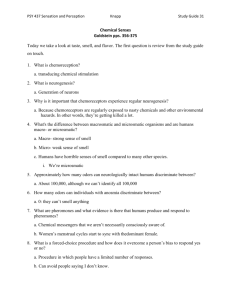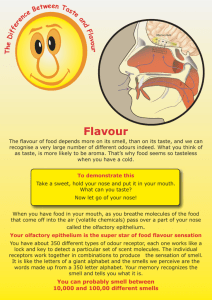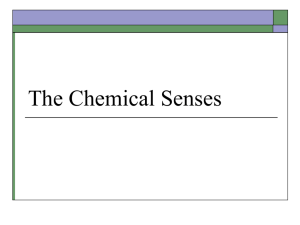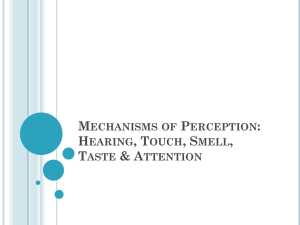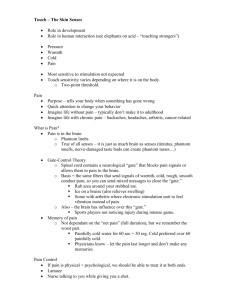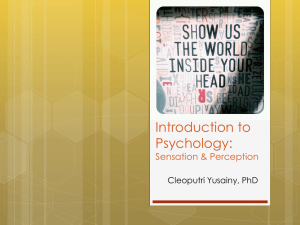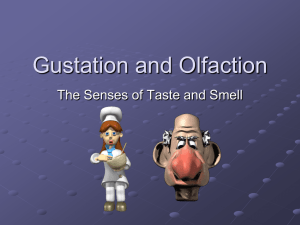Taste and Smell
advertisement
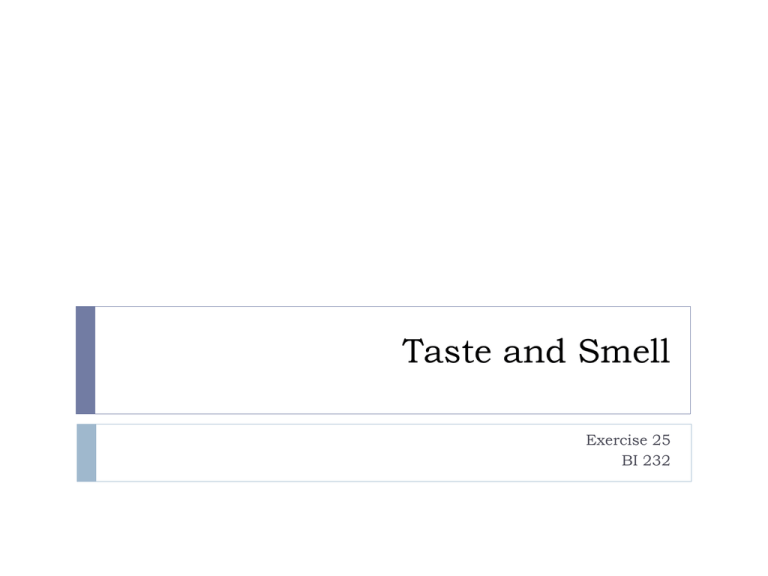
Taste and Smell Exercise 25 BI 232 Taste and Smell Both are examples of chemoreceptors in which specific chemical compounds are detected by the sense organs and interpreted by various regions of the brain Gustation Sensory receptors for gustation are located in taste buds Located mainly on the top of the tongue but also in other areas of mouth Innervated by cranial nerves facial (VII), glossopharyngeal (IX) and Vagus (X) 3 Taste Receptors Taste buds contain spindle-shaped cells Basal cells: produce daughter cells that mature in stages Gustatory cells: extend microvilli into the surrounding fluids through a taste pore 4 Contain the taste receptors Taste Bud Histology 5 Taste Determination of Solid Materials Gustatory receptors are stimulated by specific chemicals in solution Dry your tongue Put some sugar crystals on tongue Keep mouth open Can you determine what the sample is? Close mouth Can you determine what the sample is? Gustatory Discrimination 1. 2. 3. 4. 5. 7 Umami: “Beef” Salty Sweet Bitter Sour Substances must be dissolved (saliva) for the chemically gated ion channels to open Olfaction is very important in taste Mapping the Tongue for Taste Receptors We have varying degrees of sensitivity to the five tastes. People with allergies, migraines or heart problems should avoid the tasting of umami. Select a dropper bottle labeled “sweet”, “sour”, “salty”, “bitter” or “umami” Use a sterile cotton-tipped applicator, apply one of the tasting solutions to the cotton tip. Dab the entire surface of your partner’s tongue Map your tongue with all of the taste substances Do not contaminate the solutions by reusing the applicator sticks or use the same applicator stick in different solutions Olfaction Sensory receptors for olfaction are located in the olfactory epithelium consists of: Olfactory receptor cells Supporting cells Basal cells 9 Olfactory Reflex Take a small bottle of ammonia and place it under the nose of your lab partner. Have partner take a brief sniff from the bottle. If there is visible movement of the head in the posterior direction then an olfactory reflex occurred. Visual Cues in Smell Interpretation Determine whether the color of a substance has any effect on what you perceive the smell to be. Lab partner shows you a small vial labeled “almond” and then smell it Examine and smell the small red vial labeled “Wild Cherry” Close your eyes and have lab partner choose a vial for you. Can you tell which one it is? Olfactory Discrimination Obtain four vials of different scents Peppermint, almond, wintergreen and camphor Lab partner closes their eyes and try to determine the name of each scent Record how many of the smells you got correct out of the four. Testing olfactory adaptation Adaptation refers to a decreasing sensitivity to a stimulus over time. Sensitivity to an odor diminishes over time. 13 Adaptation to Smell Have partner close eyes and plug one nostril Inhale scent until the smell degreases significantly Have lab partner record time it takes. Now smell the wintergreen or peppermint vial. Does the adaptation of one smell cause the olfactory receptors to adapt to other smells? Taste and Olfaction Tests Demonstrates the dependence of the sense of smell on taste Obtain 4 or 5 small cups Label each with the name of the juice it will contain. Pour juice into the labeled cups Have lab partner sit with eyes and closed and nose plugged Give samples of juice to partner Partner should taste the sample and try to name it Test all samples with nose closed and then open nose and taste samples again Record your results. The End View Slide of taste buds Make sure that you understand the tests performed in lab
